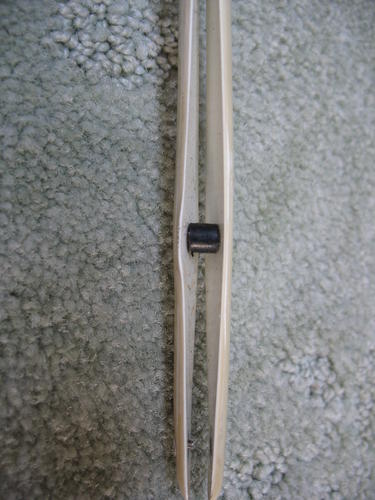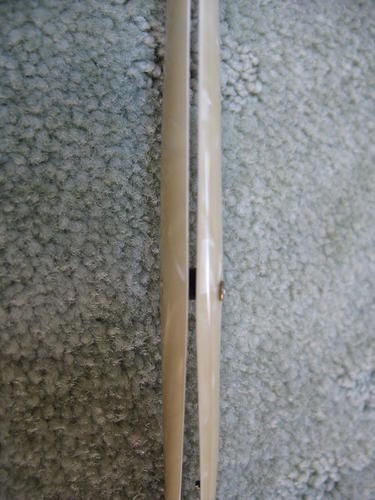Results 1 to 10 of 20
Thread: dubl duck scale warp
-
09-12-2013, 11:31 PM #1
 dubl duck scale warp
dubl duck scale warp
Recently purchased this Dubl Duck goldedge with only slight rust but a misaligned blade and warped scales (i think). My question is, what are the supposed to look like? the little black rubber/plastic center pin looks to be squished so that the scales are closer at the underside. Before i go ahead and straighten them i'd like to know if it is supposed to be that way. Also what's a good replacement for the center pin thingy? (if it needs to be replaced)


topside underside
Also, how thick is the pearl layer on these type of scales?(in case i need to do some polishing.)
-
09-13-2013, 12:38 AM #2Senior Member




- Join Date
- Nov 2012
- Location
- Across the street from Mickey Mouse in Calif.
- Posts
- 5,320
Thanked: 1185
It looks to me like the pin is bent real bad. This maybe the only problem but then again the scale may stay warped from it being that way for so long. Your should be able to hand polish with car polish no problem. Not sure how thick the pearl layer is but I think it is very thin surface thing only. I may be able to send some pics tomorrow as I am going to take a Goldedge apart that has some wasted scales on it. I will have something to experiment with and document. Don't be mad it it takes me a couple days :<0) Someone might come along and know anyway.
Good judgment comes from experience, and experience....well that comes from poor judgment.
-
The Following User Says Thank You to 10Pups For This Useful Post:
tintin (09-13-2013)
-
09-13-2013, 01:55 AM #3

I have no Goldedges, but that looks like warped scales for sure. The pin being bent is a victim, not a culprit.
You could replace the black plastic with brass tubing.
I would be careful with those scales, seen alot of DD with cel rot.
-
09-13-2013, 02:31 AM #4

Check out this link, Glen just happens to be repairing a DD Goldedge;
gssixgun straight razor repair pinning wmv"If You Knew Half of What I Forgot You Would Be An Idiot" - by DoughBoy68
-
09-13-2013, 05:01 PM #5

That's what i'm worried about. though it hasn't started yet I don't know when it will and i'll end up making new scales anyway. thing is I like the looks of these scale and i'm not sure if I can replicate the look, especially the inlays. I know they can be removed but can they be re-inlayed? I was toying with the idea of melting them in with a soldering iron. has anyone tried that?
-
09-14-2013, 09:23 PM #6Senior Member




- Join Date
- Nov 2012
- Location
- Across the street from Mickey Mouse in Calif.
- Posts
- 5,320
Thanked: 1185
If you discolor the brass all the way through you won't be able to polish it out. I did try heating them some and melting into new acrylic but stopped before color happened. I just lay them on top and make sure the glue is spread evenly. It is a hair raising experience and I would suggest lots of practice placing them before you glue. If you get glue all over the scales it is not easy to get it off. Not enough and you might as well start over. That's the easy part. Sanding them to fit is a process all it's own. Think ,forever, because if you sand off too much guess what ? Start all over again. I am by no means saying this to discourage you. Just letting you know what your in for. If you don't have the patience and eye for it then you may want to pass on the idea.
And not to start an argument with souschefdude I just don't think scales are going to bend pins and the fact the spacer is squished tells me somebody smacked the pin with a hammer. 1+1 = warped if not cracked scales. That's just too much going on to be just from the scales warping.Good judgment comes from experience, and experience....well that comes from poor judgment.
-
09-14-2013, 09:42 PM #7
-
09-14-2013, 10:26 PM #8

No arguments from me, just my opinion. Hard to tell, even if you have it in hand what has happened to it.
Just my observation. I've seen similar warping in scales that had major rot.
-
09-15-2013, 12:21 AM #9Senior Member




- Join Date
- Nov 2012
- Location
- Across the street from Mickey Mouse in Calif.
- Posts
- 5,320
Thanked: 1185
That's good to know. I was just thinking both sides, too hot, color, polish ,,, yikes ! Polishing this thin brass is not an easy affair by hand and using a Dremmel on it is more than risky. The soldering iron sounds like a good idea and if you try it make a vid. I have heated the brass and tried to melt it into the acrylic and I got to the point where I felt anymore heat would damage the brass and the plastic. I have some extra material and will experiment someday in the search for a better transfer. I think if you could find celluloid material it may be easier to use heat to press it in. Of course then your just making the same self destructing scales that were on it.
Acrylic melts at 320 degrees and brass is good to about 900. Typical soldering iron gets 450 or so ? If there is such a thing as typical.
I think it may be tricky to heat evenly enough to sink the brass into the plastic without bending the brass into a soft spot plus if you touch the acrylic with the iron at all you may get instant black.
I am surprised Glen hasn't found a way to do it yet.
Somebody needs to play around so I know these things :<0)
My best guess on how to do it would be like a branding iron. Something the exact shape of the inlay but man all the alignment and temperature control would be a pain in the buttox unless you were going to make a thousand of them.Last edited by 10Pups; 09-15-2013 at 12:25 AM. Reason: Added the branding thing.
Good judgment comes from experience, and experience....well that comes from poor judgment.
-
09-15-2013, 01:17 AM #10

here's another idea. one trick I've read about in repairing guitar binding is to use the paste left from melting the celluloid in acetone as sort of a color matched putty. Maybe plastic melts the same way and could be used as a putty to either fill in a routed out inlay pocket or give the appearance of being inlayed?


 5Likes
5Likes LinkBack URL
LinkBack URL About LinkBacks
About LinkBacks






 Reply With Quote
Reply With Quote

